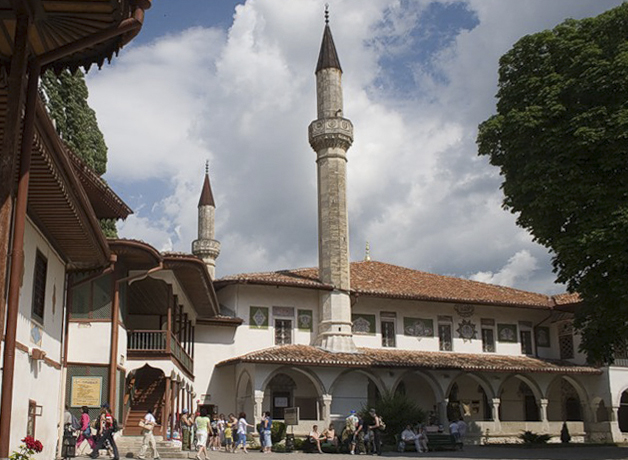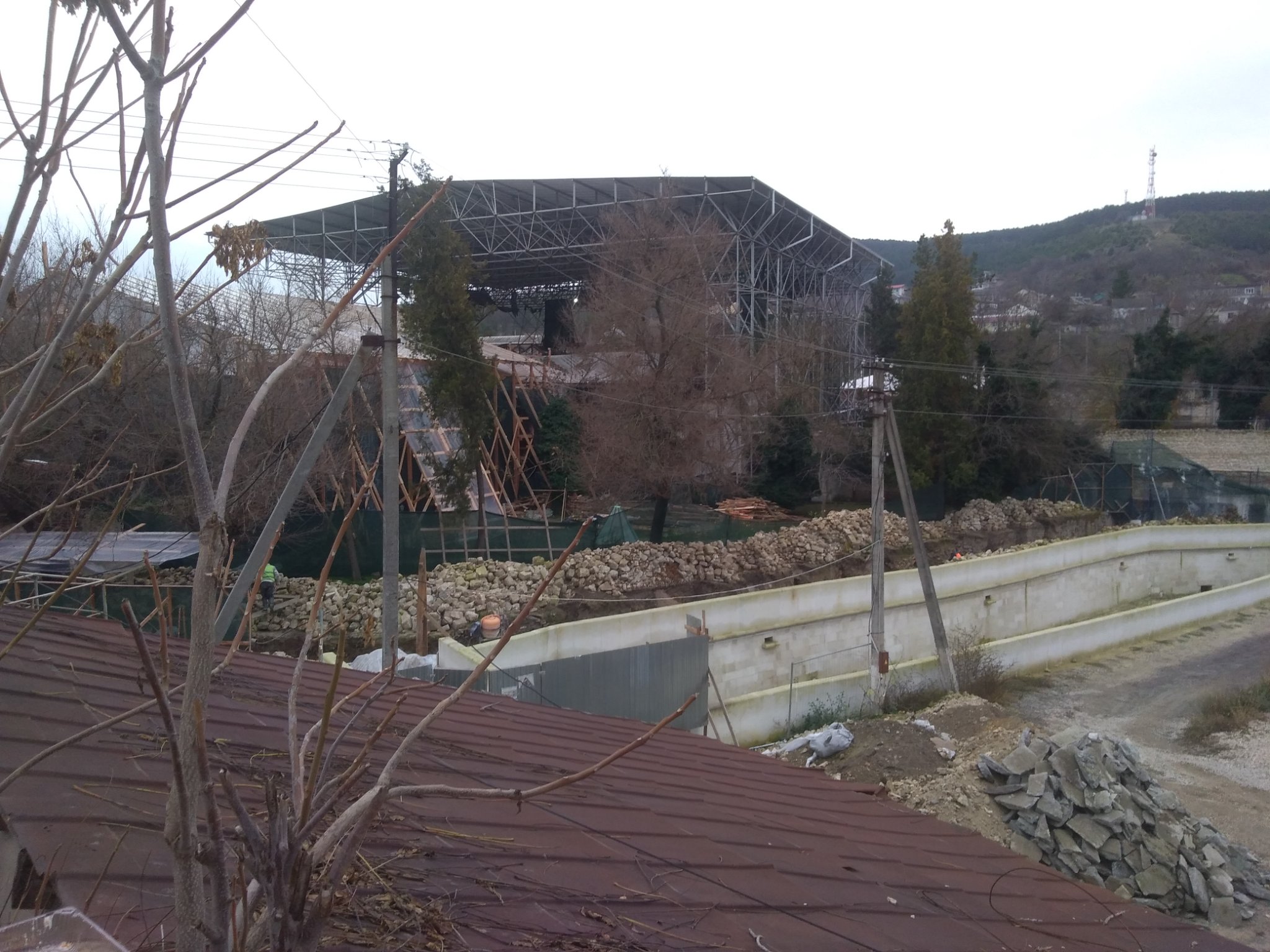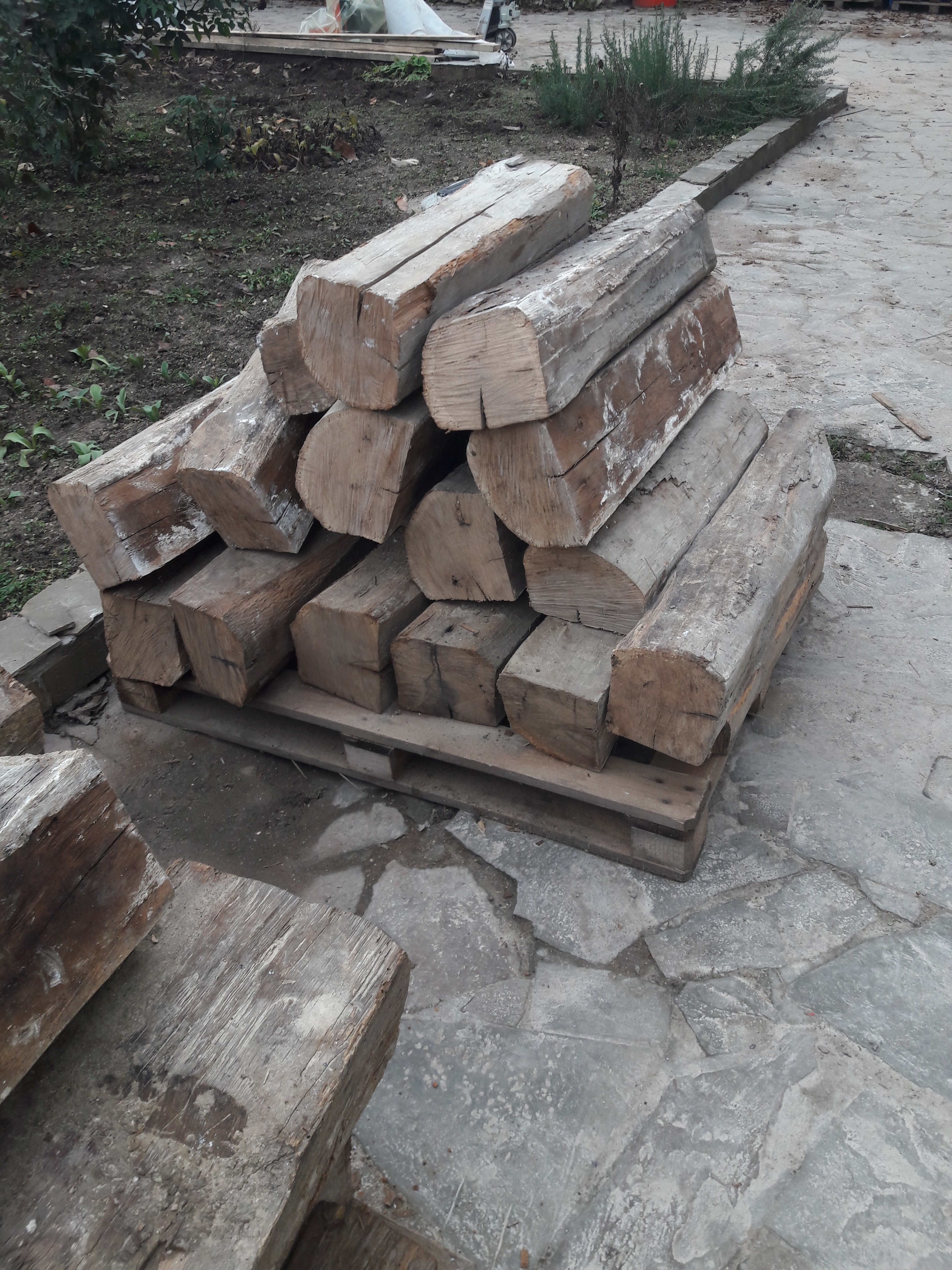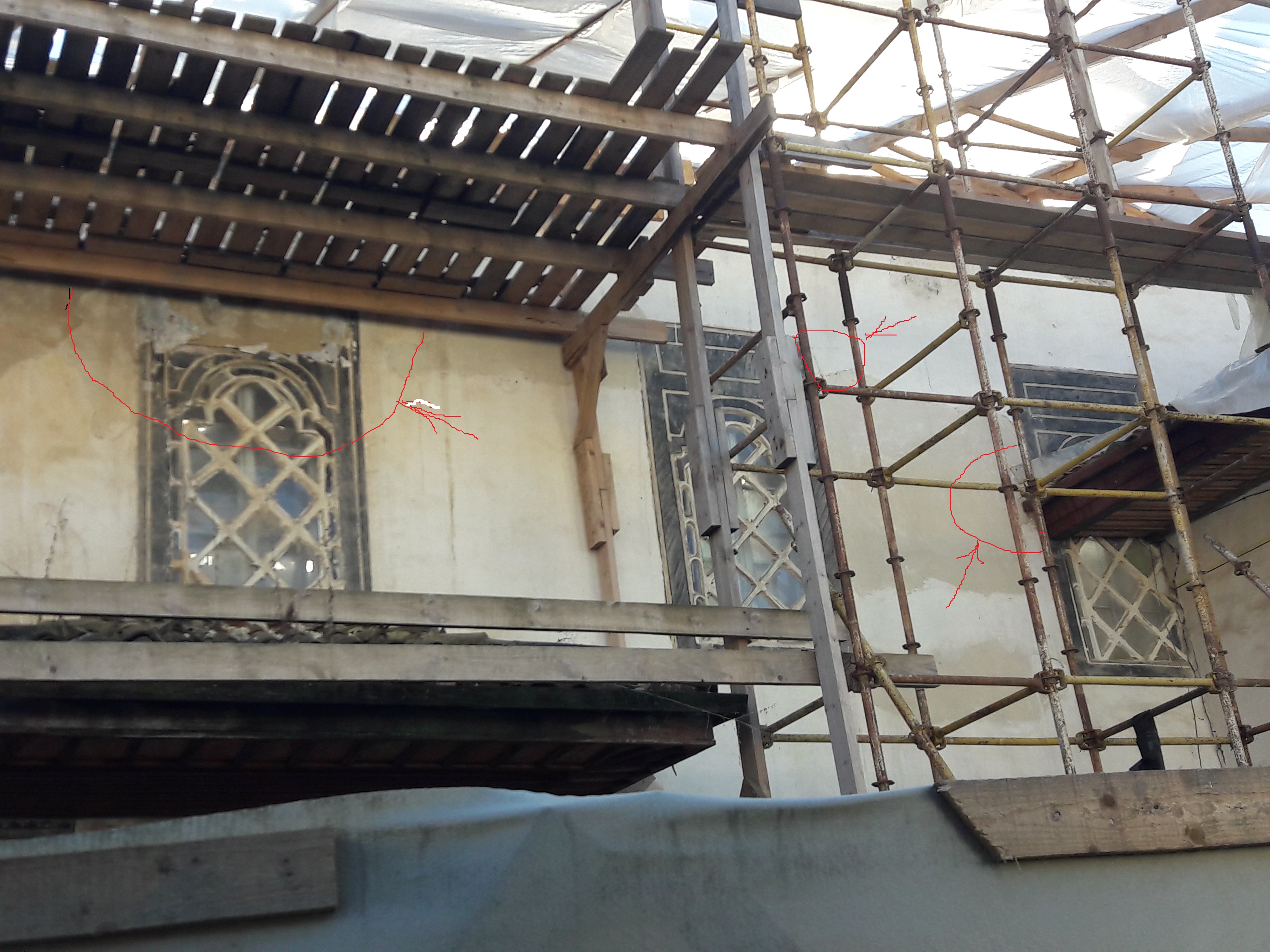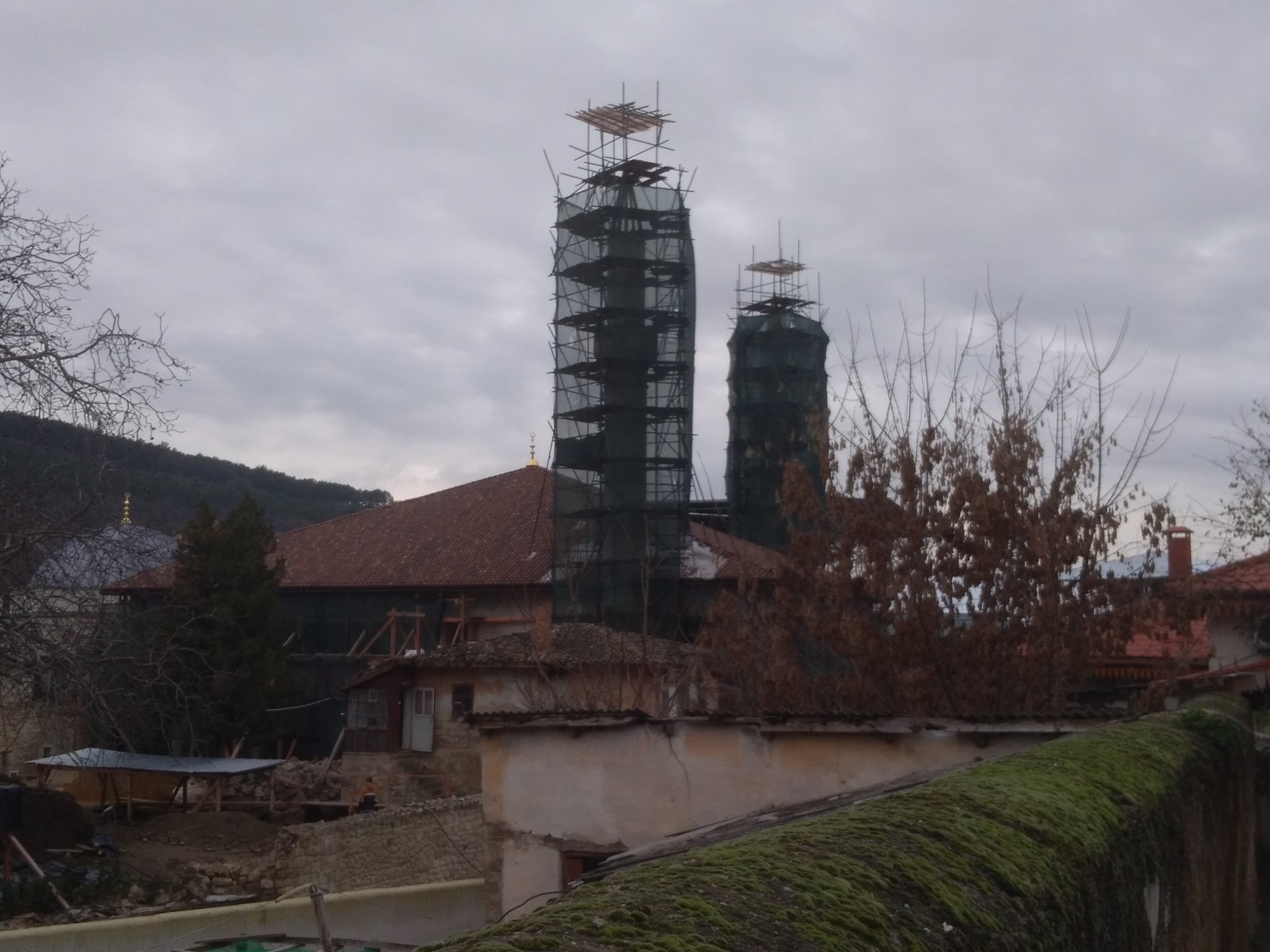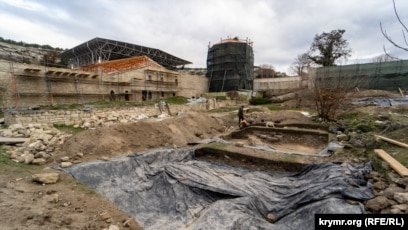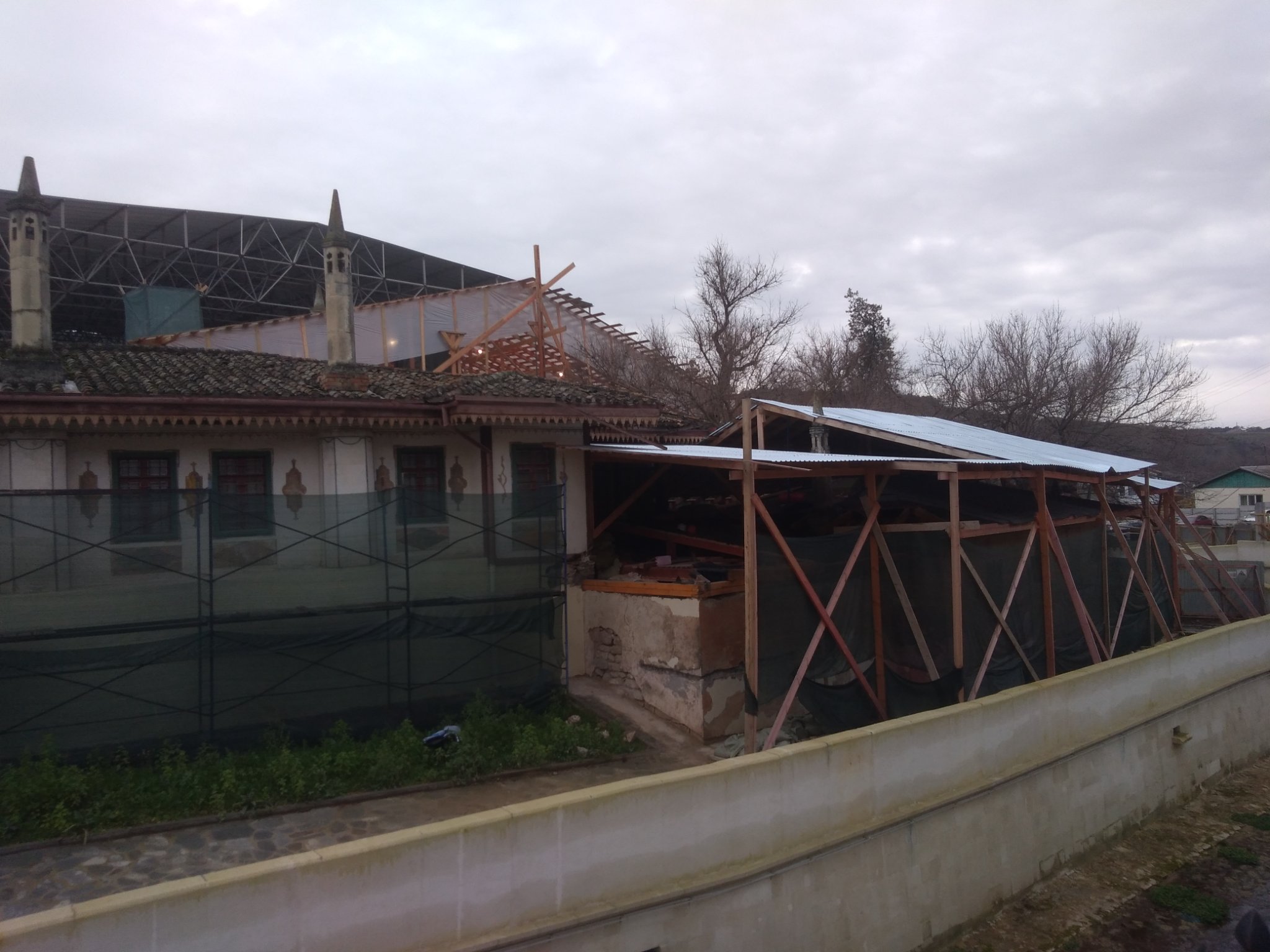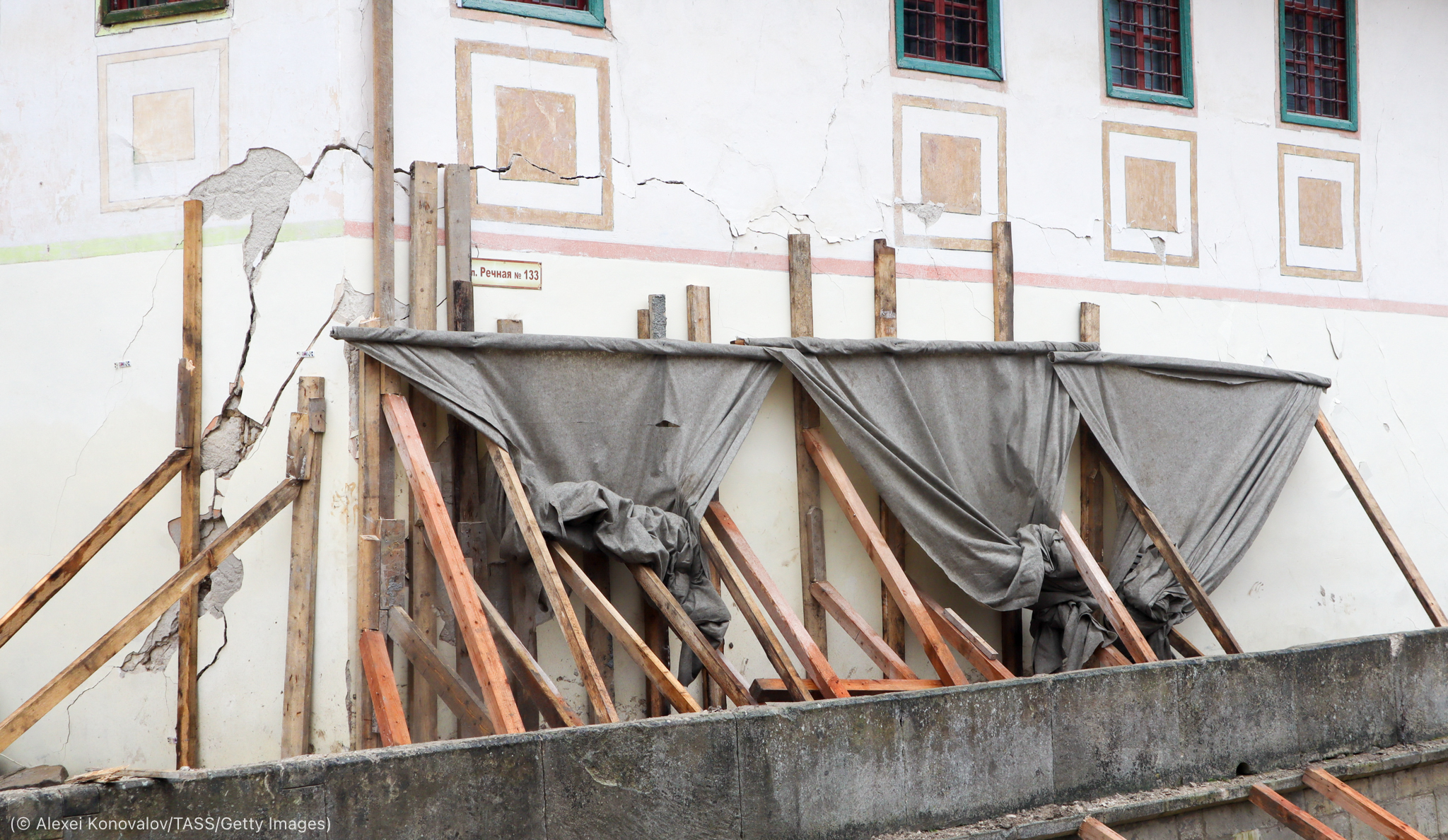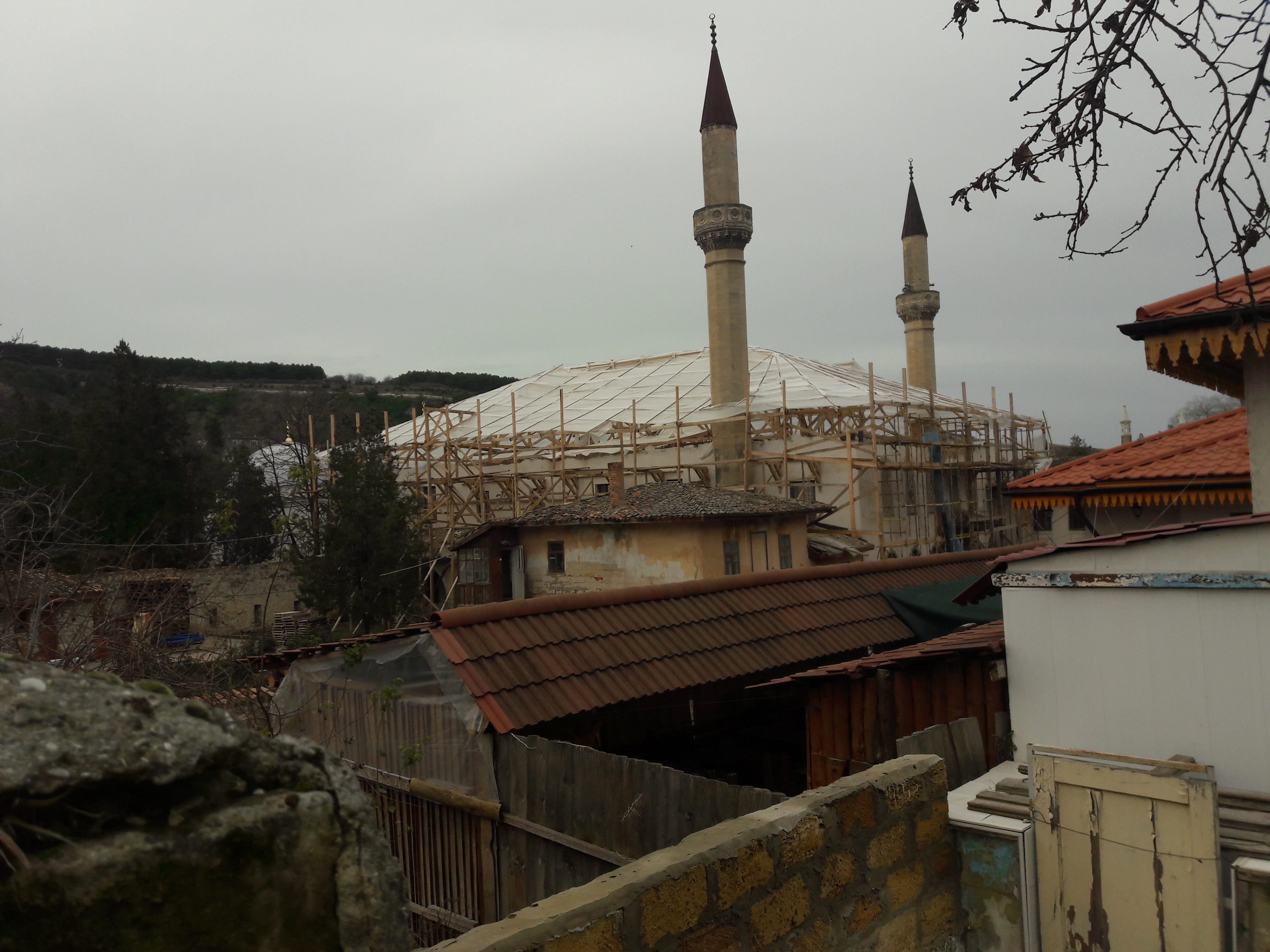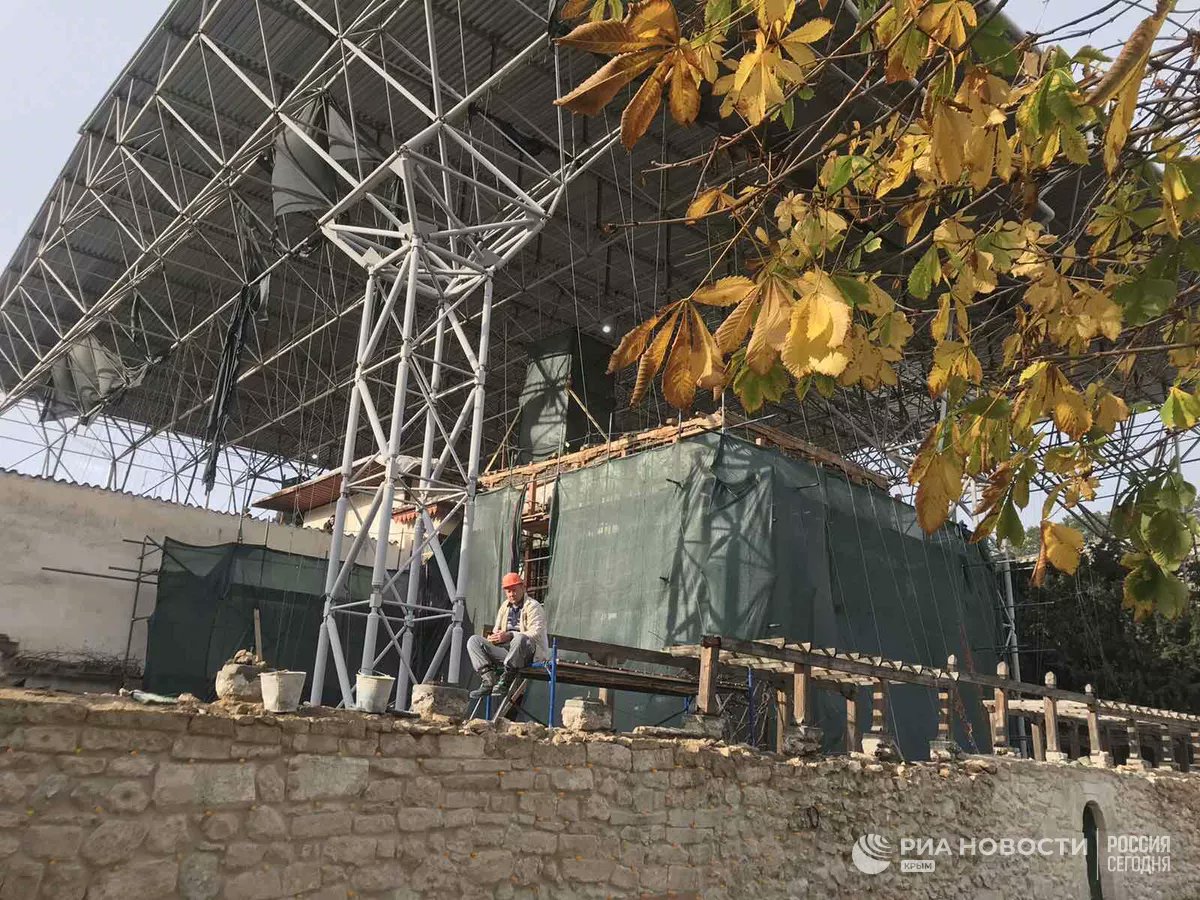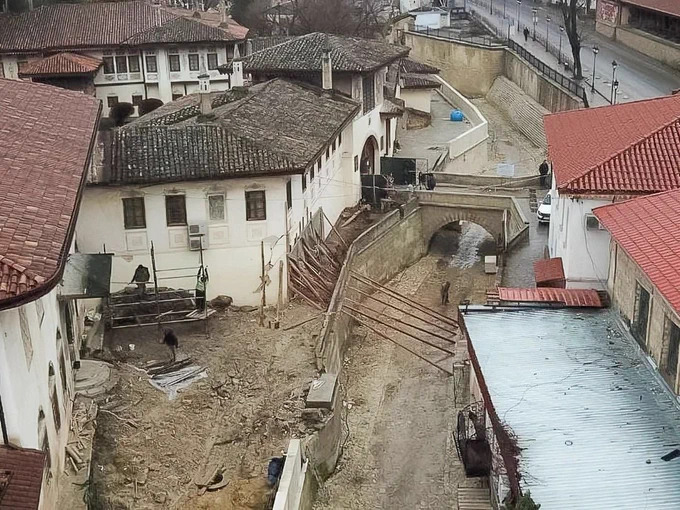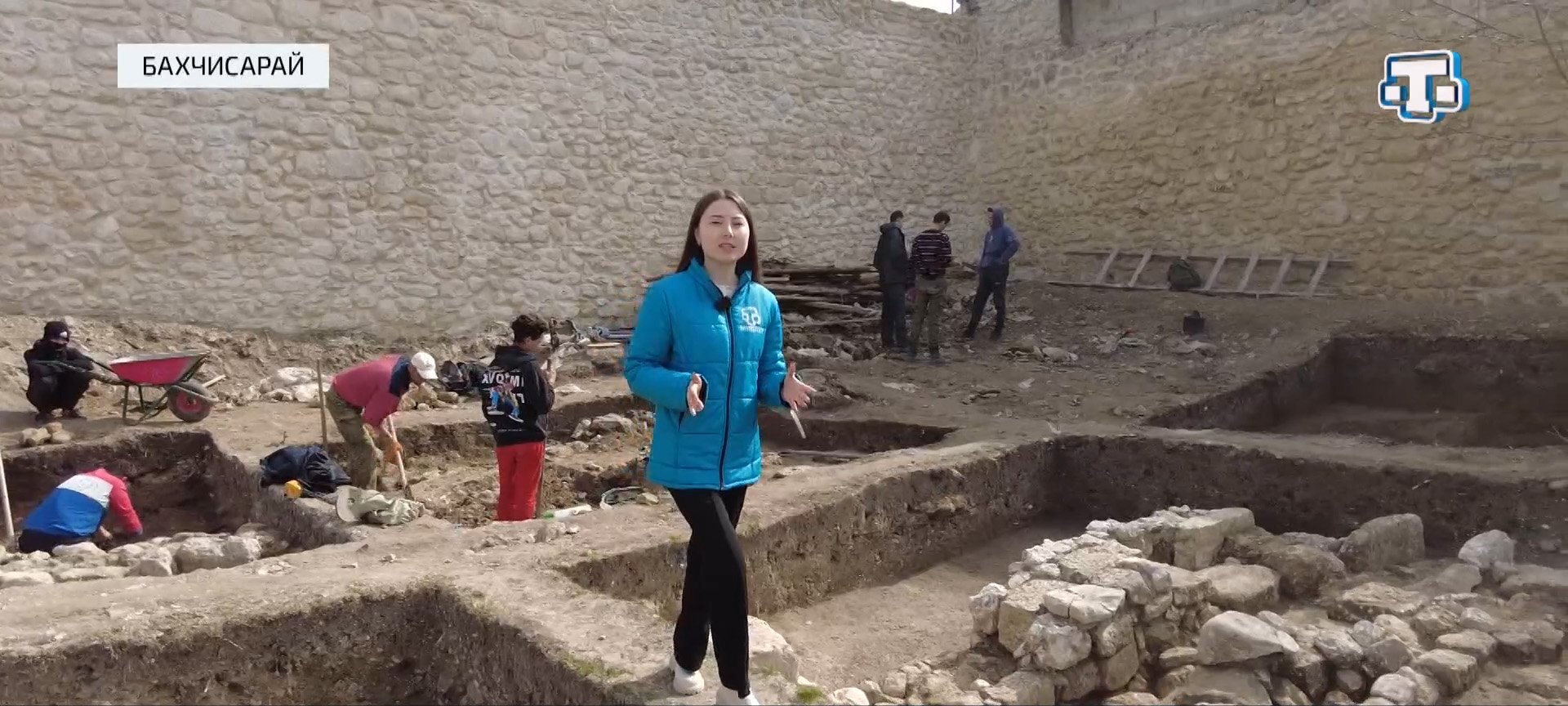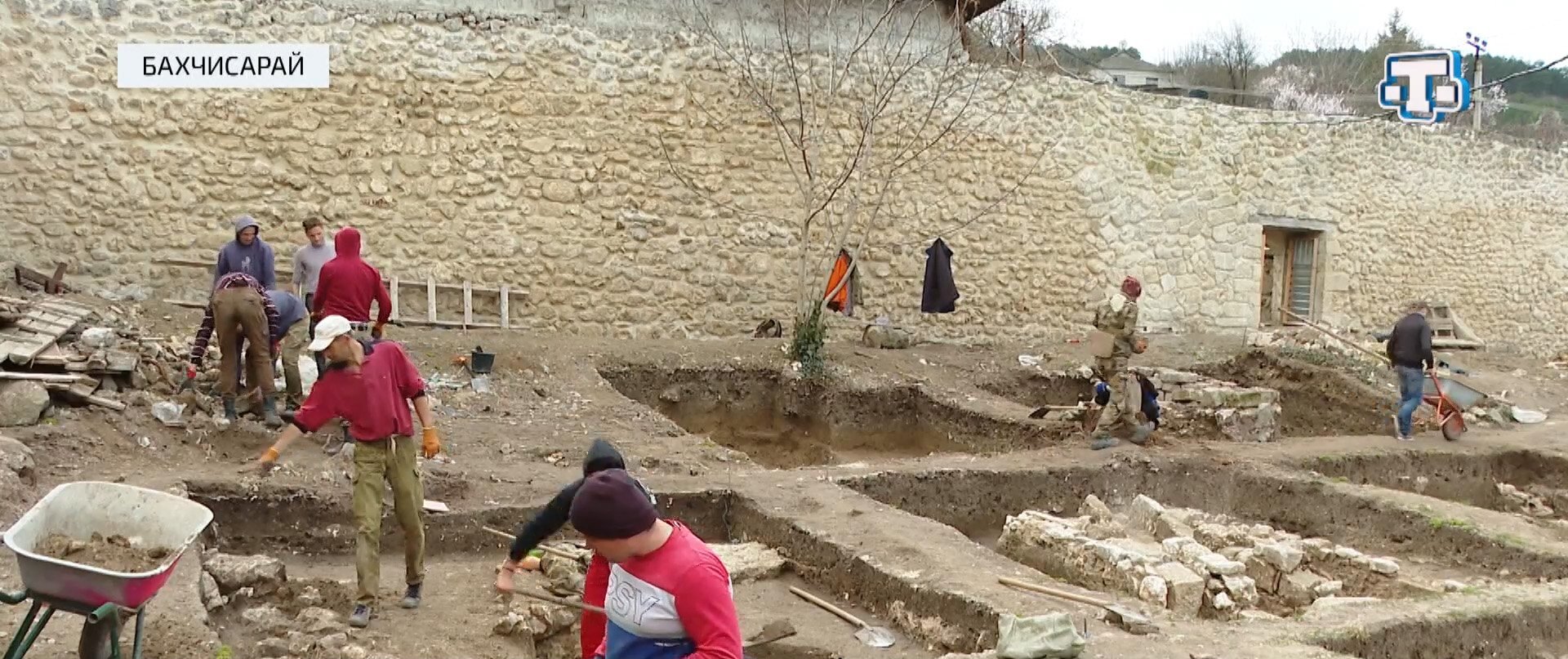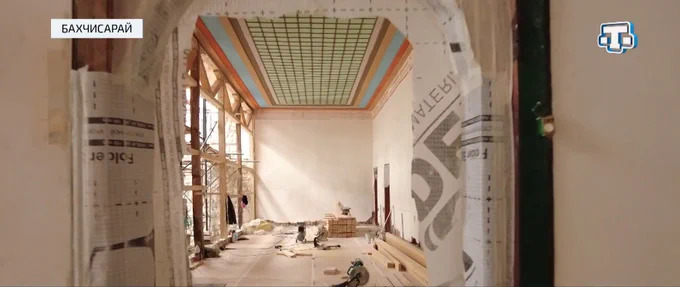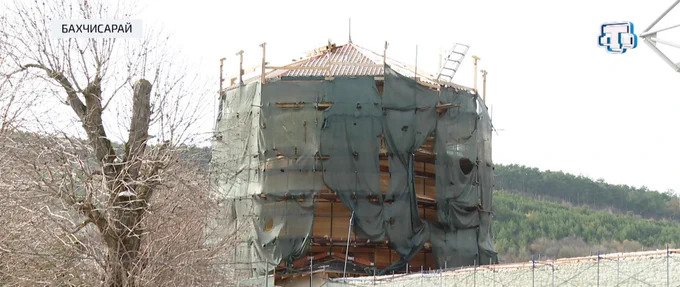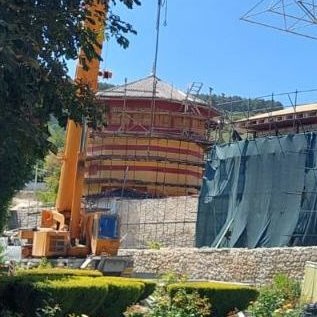General information
Location
Khan's Palace, Gastello Street, Bakhchisaray, Bakhchisaray district, Crimea, 98403, Ukraine
Kind of cultural heritage
Object of architectureObject type
ComplexesViolation type
Damage Illegal archaeological excavations Alteration/reconstruction/construction works on cultural heritage sites MisappropriationResearch zone
Autonomous Republic of CrimeaMap
Object history and violation description
(THE MATERIAL IS CONSTANTLY UPDATED)
The Palace of the Crimean Khans (hereinafter referred to as the Khan Palace) is the main residence of the rulers of the Crimean Khanate. The Crimean Khanate is a historical state of the Crimean Tatars that existed from the mid-15th century until late 18th century (and was part of the Golden Horde until the 15th century). It was located in the Crimean Peninsula, the southern regions of Ukraine and the North Caucasus, and in April 1783, it was annexed by the Russian Empire. The family sign of the ruling Giray dynasty in the khanate – tamga – is now an element of the national flag of the Crimean Tatars. Bakhchysarai Khan Palace from the first third of the 16th century was not only the house of the khan but also the administrative and political center of the state. By the way, this was not the only palace of the ruling dynasty; at that time, there were five more small khanate palaces in Crimea, namely palace complexes in Kyrk-Yer, Ulakla-Sarai, Alma-Sarai, Kacha-Sarai, Suiren-Sarai.
It is now included in the Tentative List of UNESCO Cultural Heritage, the protection number in the State Register of Immovable Monuments of Ukraine is 010077. It is the world’s only monument of Crimean Tatar palace architecture and the sole preserved palace complex of the Giray dynasty, descendants of Genghis Khan.
Until January 1, 2015, the complex was on the balance sheet of the Crimean republican institution Bakhchysarai Historical and Cultural Reserve.
History
The beginning of the construction of the Palace (which, by the way, became the starting point for the construction of the new capital that later became known by the name of the palace, Bakhchysarai (meaning “palace-garden” in the Crimean Tatar language)) dates back to 1532–1533. The construction of the Palace is associated with the name of Khan Sahib I Giray, remembered not only as the founder of the new capital of the Crimean Khanate but also as a great reformer, the ruler of Kazan (where, among other things, he organized resistance to Moscow's attempts to take over Kazan) and the Crimean Khanate.
The oldest objects of the complex are the Alevizo de Montagnano Portal or Demir-Capu (“Iron Portal”), created in 1503 by the famous Italian master Alevizo de Montagnano, the Sara Güzel baths (1533) and the Khan’s Mosque (1532). Initially crowned with a dome, after the fire of 1736, arranged by order of the Russian field marshal Burghard Christoph von Munnich, the mosque was badly damaged and rebuilt. The roof of the mosque became four-pitched, covered with tiles and crowned with a spire.
The annexation of the Crimean Khanate in 1783 by the Russian Empire marked the beginning of the “imperial” period in the historiography of the Bakhchysarai Palace complex. It was characterized by attempts to prepare and carry out restoration activities, connected either with the rehabilitation of the complex after damage caused by the natural disaster or with the expectation of high-ranking guests in Bakhchysarai. Lack of funding, absence of highly qualified workers and, frankly, the desire to degrade the historical status of the palace complex led to the fact that a large part of the buildings was irretrievably lost while the appearance of the surviving ones was often distorted beyond recognition.
After the deportation of the Crimean Tatars from their historical homeland in 1944, the Soviet authorities sought to eradicate all references to them: they carried out "toponymic repression" on the peninsula, destroyed Crimean Tatar monuments, burned manuscripts and books, opened cinemas and shops in mosques. After such almost total annihilation, the miraculously preserved complex of the Bakhchysarai Khan Palace became not only a symbol of birth, development and statehood in this territory but also a symbol of rebirth in the native land for the Crimean Tatars, who began to return en masse from places of deportation to Crimea in the 1980s and 1990s. A similar filiation of the semantic space accorded to this historical object is also characteristic of an earlier period. It was not by chance that the Khan’s Palace was chosen as the venue for the first Kurultai of the Crimean Tatar people on November 26 (December 9, according to the New Style) in 1917.
New occupation: 2014
Appropriation: Before the occupation of 2014, the sites were on the books of the Crimean Republican Institution (CRI) “Bakhchysarai Historical and Cultural Reserve.” In 2014, the property complex of the CRI “Bakhchysarai Historical and Cultural Reserve” was illegally appropriated by the occupation government of the so-called Republic of Crimea. In 2015, the entire property complex was entrusted to the Bakhchysarai Historical, Cultural and Archaeological Museum-Reserve, established by the occupation authorities. In 2015, the nominated sites were illegally included, by the Order of the Government of the Russian Federation, into the Unified State Register of Cultural Heritage Objects (Monuments of History and Culture) of the Peoples of the Russian Federation.
Already 100 years after such a landmark event, this unique architectural ensemble of Crimean Tatar, Ukrainian and Eastern European history fell prey to Russian aggression. Over the past seven years, construction companies, with the consent of the Russian occupation authorities and the public authorities of the Russian Federation, have been carrying out illegal (from the standpoint of international humanitarian law and international human rights law) construction/repair works on the monument, which lead to changes that worsen its aesthetic, historical, scientific and artistic value under the guise of “cultural heritage protection measures.”
The oldest building of the complex – Biyuk Khan Jami (“Khan’s Mosque,” protection number in the State Register of Immovable Monuments of Ukraine – 010077/8) was the first to be destroyed. The methods employed by the occupying authorities of Crimea in relation to the restoration sparked outrage among Crimean activists, and later became the subject of relevant UNESCO reports.
The permit for “restoration” works at the Great Khan’s Mosque (the “story” about the restoration of the Palace began exactly with this object) was issued on July 25, 2017. Work started in October 2017.
The Great Khan Mosque was certainly in need of restoration, but it had to be based on preserving its authenticity, not just the appearance of the monument.
The UkrNDIprojektrestavratsiia Institute, which was preparing the mosque restoration project back in 2014, concluded that:
- of the 22 ceiling beams with a length of 9.5 m, it was planned to replace three and restore one beam, as well as installing an additional reinforcement with a metal corner bracket on top of 4 beams;
- one 9.5 m long cross beam was due for replacement;
- out of 82 floor beams with a length of 6.5 m, it was planned to replace three and restore four beams, as well as strengthening six beams with a metal corner bracket.
These findings were confirmed during the additional examination of the ceiling condition in 2015. A temporary support structure was installed above the entrance to the mosque from the side of the Churuk-Su River.
However, at the design stage, the occupiers, instead of restoring individual elements of the historical roof of the mosque, decided to completely dismantle the roof and apply construction methods and norms meant for modern buildings to the cultural heritage object. This was done not by professional restorers but by builders using heavy machinery and jackhammers. Such works were accompanied by vibration of the walls of the mosque building and led to extensive damage, including to frescoes on the southern and western facades of the mosque (18th–19th centuries). The analysis of the dismantled elements of the beam system of the roof confirms that there is no need for complete dismantling since almost 95% of the beam system was in a proper condition.
Furthermore, modern construction materials and technologies are used at the cultural heritage site, which is unacceptable. It primarily comes down to the use of composite materials for beam construction, concrete solutions with the use of reinforcement. Ancient hand-made barrel tiles (keramet or tatarka) are replaced by Spanish factory-made monk-and-nun tiles imitating antiquity. At the same time, the technology of laying tiles on clay was completely violated (it was also replaced with modern fasteners).
The contractor does not calculate the additional load on the walls, caused due to new layers (a new beam system, reinforced with the use of concrete, seismic belt, etc.). Such an indicator should necessarily be calculated during the preparation of the project of restoration works. The walls of the Great Khan Mosque were built in 1533, so preliminary studies of the condition of foundations, walls, materials used in the construction process, solutions, calculation of the effect of additional load, etc. should show the possible variability of materials and methods of restoration work. Ignoring these factors is also an indicator of the lack of a professional approach to restoration.
All the work carried out in 2017–2018 certainly overloaded the structure, and the concrete accelerated the erosion of the rubblework of the walls. Roof dismantling work was carried out in the autumn-winter period, with the monument left unprotected from precipitation. The polyethylene coating as a rain protection system did not meet even basic protection requirements and led to a large amount of rain falling into the building. All this, alongside the use of harsh methods of facade washing (for unknown reasons), led to the over-saturation of soil and its subsequent subsidence and horizontal movement. As a result of this, in 2018, numerous breaks and cracks appeared on the northern facade of the mosque, the facade of the Secular Building and the eastern minaret of the mosque, which had a slight slope before the works started.
Cultural heritage objects in the immediate vicinity of the construction works (near the mosque) were also damaged. Cracks were recorded on some gravestones of the Khan cemetery, which, according to experts, probably appeared as a result of lack of protection from mechanical impact.
On February 8, 2021, the northeastern corner of the Secular Building detached from the massif of walls as a result of the subsidence and horizontal movement of soil, which was accompanied by spiral deformation.
To date, the so-called "restoration works", which are, in fact, ordinary construction works, have covered almost all objects of the complex. Works are being carried out in the Main Building, Falcon Tower, Stable Building, Library Building, Harem and landscape facilities.
In the fall of 2021, the works were focused on the area in front of the Khan Mosque to "deepen the channel" of the Churuk-Su River. The works were carried out without thorough research of the monument, which should precede restoration. This led to the destruction of the layering in the riverbed below the level of the mainland, a section of the riverbed (dated no later than the 18th century), part of the embankment lining foundations and bridge piers. Activists and specialists have concluded that this accelerated the processes of subsidence and horizontal movement of soil masses, on which the northern facade of the Biyuk Khan Jami and the Secular Building rest. In this condition, the object entered the winter period of 2021–2022. Since the end of December 2021, the city of Bakhchysarai has experienced a lot of precipitation, causing excessive water saturation of the open area in front of the mosque.
Events of 2022–2023:
In the fall of 2022, the NGO Crimean Institute for Strategic Studies received information about plans to replace the marble floor of the Divan Hall of the Khan Palace with hexagonal ceramic tiles.
On October 16, 2022, information about the state of the new beam system came up. According to activists, the composite materials of the OSB technology, which the new roof of the Great Khan Mosque was built of, began to peel off. It was decided to fasten the beams together with steel clamps, which will create an additional load on the walls.
Back in 2017, Crimean museums began preparing museum treasures for evacuation. This information was confirmed by the General Staff of the Armed Forces of Ukraine in October 2022. Such a decision, if implemented, will be considered a violation of international humanitarian law and international standards in the field of human rights.
On December 4, 2022, information appeared about the dismantling of the fence of the embassy courtyard and the kitchen courtyard, the beginning of the "restoration" of the minarets of the Great Khan Mosque.
An exhibition of supposed Crimean Tatar folk costumes was opened on the central square. Read why it is a devaluation of Crimean Tatar culture in the article: Click to view the material.
On December 16, 2022, information came up about the dismantling of the roof of the Golden Cabinet of Qirim Giray Khan.
January 22, 2023 – information came up about the destruction of the foundations of the Khan Madras
March 14, 2023 – a photo came up of the Harem after renovations with visible signs of the use of modern technologies and construction materials and a pseudo-historical visualization.
March 14, 2023 – information came up about plans to install an amphitheater and a stage on the territory of the Persian courtyard
This information is constantly updated…
Aggressive "reconstruction": expert assessments
Modern world practice gives preference to restoration, whereas reconstruction is resorted to only in exceptional cases, such as when a monument is destroyed as a consequence of a military conflict or natural disaster. Restoration works aim to preserve the authentic material structure as a carrier of historical, scientific, architectural and artistic information and to give it a form in accordance with the historical and cultural content. However, the activities carried out by the occupier in Bakhchysarai destroy the historical object and decontextualize it. Back on February 22, 2018, Crimean restoration specialists already expressed concern about the works at the Great Khan Mosque.
In the process of studying information from open sources about works on the territory of the complex, several serious violations of the fundamental principles of restoration were revealed:
the principle of scientificity;
the principle of reasonableness when determining restorative intervention;
the principle of reversibility of the work performed.
All measures of conservation, restoration and fire prevention, sanitary, environmental protection, etc., which are carried out at the monument, must not:
- lead to changes in the monument, impairing its aesthetic, historical, scientific or artistic value;
- be aimed at eliminating the significant contributions of all eras to the creation of the monument.
The restoration should have been preceded by a careful study of the monument. It should have included the study of:
- possible options for eliminating damage and specific features of historical building materials and mortars;
- elements and details of the original appearance of the mosque building, as well as later layers, additions and reconstructions, their historical value.
In addition, a historical and archival analysis should have been conducted. Taken together, all of these measures would have given restoration professionals the opportunity to restore the original appearance, preserve the historicity and authenticity of the monument.
In reality, the studies carried out by the occupation administration were superficial, and the engineering decisions adopted confirmed the lack of a professional restoration approach.
According to the conclusion of the experts of the International Center for the Study of the Preservation and Restoration of Cultural Property (ICCROM), the work carried out at this object is “characteristic of a new construction. Mass replacement of wooden structural elements with modern materials, which are not inherent in the culture of Crimean Tatar construction, distorts the historical authenticity of the entire ensemble, violates the aesthetic value and complexity of the monument, causes irreparable damage to the history and culture of the Crimean Tatars.”
Analysis of open electronic Crimean sources and photos made by experts showed that the construction company ATTA Group, which had no experience in restoration work, was chosen as the general contractor and author of the project in 2016. Kiramet LLC was chosen as the subcontractor and project developer in 2017. The client of the works was the so-called Committee for the Protection of the Cultural Heritage of the Republic of Crimea, run by Sergey Yefimov, who had been engaged in cartography until 2014. The first deputy chairman of the committee is Aleksandr Didenko, an athlete, who had not been involved in restoration before.
In July 2018, a contract was signed with KIRAMET LLC for the development of scientific project documentation for the restoration of the following objects: the Khan Mosque (II stage), the Dyurbe Dilyara-Bikech tomb, the Northern Dyurbe tomb, the Southern Dyurbe tomb.
The documentation for the restoration of the objects of the Khan's Palace was also developed by MEANDR LLC, which broke almost all the contracts it was to fulfill in Crimea. In August 2018, Meander LLC undertook a commitment to develop scientific project documentation for the restoration of the following objects: Main Building (repair and restoration works), Embankment with three bridges, Harem; and develop scientific project documentation for the restoration of the following objects: Count’s (Secular) Building, Khan's Kitchen, Stables, Library Building, Falcon Tower, Catherine’s Mile.
In August 2019, KIRAMET LLC signed a contract for the development of scientific project documentation for the restoration of the following objects: Rotunda of Tomb, 18th century, Sary-Guzel Bath, 1533.
In December 2019, a contract for restoration works on the following objects was concluded with HEFEST LLC: Count’s (Secular) Building; Khan’s Kitchen; Stable Building; Library Building; Falcon Tower.
Also in December 2019, SCIENTIFIC RESTORATION CENTER LLC concluded a contract for restoration works at the following sites: Dyurbe Dilyara-Bikech Tomb; Northern Durbe Tomb; Southern Durbe Tomb.
In December 2020, RESTORATION COMPANIES JSC concluded two contracts:
- the first contract – for the development of scientific project documentation for the restoration of the Main Building of the Khan's Palace;
- the second contract – for the development of scientific project documentation for the restoration of the object Harem of the Khan’s Palace.
In February 2021, two contractors were identified for the further "restoration" of the objects of the Bakhchysarai Palace:
- the monuments Rotunda of Tomb and Sara Guzel Bath are being "restored" by the Moscow company STK Am-Bud;
- the "restoration" of the Khan’s Mosque is carried out by the Construction Company Stroy Mir Rekonstruktsiya.
The embankment of the Khan's Palace has been under repair since December 2020. The works are being carried out by NST LCC.
Thus, in Bakhchysarai Khan Palace, contractors are constantly changing, some of them later declare their bankruptcy.
According to the "plan for the revitalization of the palace square,” it is planned to install animal statues, which does not correspond to the cultural area of the monument (because of aniconism in Islam). It is also planned to demolish historical buildings dating back to the 17th century.
Researchers record the holding of Christian holidays on the territory of the Khan’s Palace, which to some extent contributes to the historical decontextualization of cultural heritage.
By depreciating (even through reconstruction) the historical significance of the object, which is an important symbol for the indigenous people of Ukraine, the occupation administration continues to implement a long-term program devised during Soviet times, aimed at the destruction of historical memory, a change in worldview and the assimilation of the Crimean Tatar ethnic group.
Options for justice: from Kyiv to The Hague
Under the procedural leadership of the Prosecutor's Office of the Autonomous Republic of Crimea and the city of Sevastopol, a pre-trial investigation of a number of criminal proceedings is being carried out regarding the facts of illegal exploration, archaeological work, intentional destruction, destruction and damage to monuments of history and cultural heritage on the temporarily occupied territory of the Crimean peninsula.
The illegally established authorities on the temporarily occupied territory of the Crimean peninsula in the city of Bakhchysarai illegally appropriated 32 real estate objects that are part of the monument of national importance Khan’s Palace, which is a component of the Bakhchysarai State Historical and Cultural Reserve. It has been established that this historical monument is being deliberately destroyed and damaged by large-scale illegal construction works.
The described gradual modification of the unique cultural and historical components of the Bakhchysarai Khan Palace as a result of the so-called "restoration" can be regarded as one of the factors of cultural erasure carried out by the occupying power in Crimea against the Crimean Tatar people. In turn, cultural erasure can be qualified as a crime against humanity in the form of persecution and even as a crime of genocide. It is clear that solely carrying out the "restoration" itself is not enough to unequivocally affirm the commission of one of the above-mentioned international crimes. However, the purposeful discriminatory targeting of cultural objects and related intangible cultural heritage of a specific ethnic or religious community can serve as one of the substantial indications of the possible existence of group persecution and/or genocidal intent aimed at the partial or complete destruction of the identified group by the perpetrators, who participate in other illegal actions against the Crimean Tatar people. The world community, particularly the PACE, is increasingly aware of the importance of such an inclusive vision of violations against tangible and intangible cultural heritage, which cumulatively lead to the erasure of cultural identity. That is why it is important to document such violations in the most nuanced way possible and substantiate their interconnection with other international crimes in order to implement national and international criminal processes and initiatives, establish the truth and ensure the payment of reparations.
1 Aniconism in Islam is the avoidance of images of living beings in some forms of Islamic art. Islamic aniconism derives partly from the prohibition of idolatry and partly from the belief that the creation of living forms is the prerogative of God. Although the Qur'an does not explicitly forbid the visual representation of any living being, it does use the word musawwir (creator of forms, artist) as an epithet of God. The Hadith Corpus (sayings attributed to the Islamic prophet Muhammad) contains more explicit prohibitions against depicting living creatures, urging artists to "breathe life" into their images and threatening them with punishment on Judgment Day. Muslims have interpreted these prohibitions differently in different times and places. Islamic religious art is usually characterized by the absence of figures and the extensive use of calligraphic, geometric and abstract floral patterns.
2 In particular, the investigation sees signs of criminal offenses set forth in Part 1, Part 3 of Art. 298, Part 2 of Art. 201, Art. 341, Art. 356, Part 1 of Art. 438 of the Criminal Code of Ukraine
Gallery
Additional files
- Letter of the ICCROM National Committee
- Expert opinion of the Center for Monument Studies of the National Academy of Sciences of Ukraine
- Appeal to UNESCO
- Act State historical and cultural expertise of the project documentation on preservation of the object of cultural heritage of federal significance: "Khan Palace (XVI-XIX centuries): Khan Mosque (1740-1743)"
Involved persons
- Architect-in-Chief of the so-called BIKAMZ - Rustem Umerov
- Director of the Museum of History and Culture of Crimean Tatars of the so-called BIKAMZ - Meryem Seytumerova
- Director-General of Atta Group LLC - Natalya Kriavkina
- Director-General of Kiramet LLC - Yulia Ivanishkina
- Director-General of Meander LLC - Elena Zavadskaya
- Architect-in-Chief of the Meander LLC project - Vasiliy Pak
- Restoration Director of Meander LLC - Dmitriy Volkov
- Director-General of Scientific Restoration Center LLC - Aleksandr Menshikov
- Founder of Scientific Restoration Center LLC - Vladislav Peshkov
- Director-General of Restoration Companies JSC - Mariya Lunina
- Director-General of NST LLC - Vladimir Missarzhevskiy
- Chairman of the so-called State Committee for the Protection of Cultural Heritage - Sergey Efimov
- Chief specialist of the Architectural and Restoration Department of the so-called State Committee for the Protection of Cultural Heritage - Larisa Safonova
- Consultant of the Architectural and Restoration Department, so-called State Committee for the Protection of Cultural Heritage - Nadezhda Bozhko
- so-called Chairman of the Bakhchysarai District Council - Olga Uraykina
- so-called Head of the Bakhchysaray District Administration - Lyudmila Puchkova
- so-called First Deputy Head of the Administration of Bakhchysarai District - Enver Ablayev
- so-called Mufti of the Muslims of Crimea - Emirali Ablaev
- so-called Deputy Mufti of the Muslims of Crimea - Esadullah Bairov
- Custodian-in-Chief of the so-called BIKAMZ (discharged as of December 2022) - Oksana Alpashkina
- Head of the Department of Preservation, Use and Restoration of Cultural Heritage Objects of the so-called BIKAMZ - Alexandra Morozova
- Architect-in-Chief of Kiramet LLC - Andrey Tkachuk
- Director-General of Restoration and Construction Company Hefest LLC - Danila Chuliukin
- Director-General of the Construction Company Stroymirrekonstruktionsiya LLC - Ildar Safiullin
- First Deputy Chairman of the so-called State Committee for the Protection of Cultural Heritage - Aleksey Belyantsev
- so-called former Chairman of the Bakhchysarai District Council - Refat Derdarov
- so-called Deputy Mufti of the Muslims of Crimea - Ayder Ismailov
- Director-General of the so-called BIKAMZ - Vadim Martiniuk
Video gallery
Sources
- On October 16, 2022, information appeared on the condition of the new beam system of the Great Khan Mosque.
- The NGO Crimean Institute of Strategic Studies received information about plans to replace the marble floor of the Divan Hall of the Khan Palace with hexagonal ceramic tiles.
- On December 4, 2022, information appeared about the dismantling of the fence of the embassy courtyard and the kitchen courtyard, the beginning of the "restoration" of the minarets of the Great Khan Mosque.
- On December 16, 2022, information about the dismantling of the roof of the Golden Cabinet of the Crimean Giray Khan came up.
- Researches see evidence of the celebration of Christian holidays on the territory of the Khan’s Palace, which in a certain way fosters the historical decontextualization of cultural heritage.
- Ibrahimova, A.M. (2013). The Bakhchysarai Khan Palace of 16–18 centuries. Simferopol. Institute of Archeology of the National Academy of Sciences of Ukraine.
- Back in 2017, Crimean museums began preparing museum treasures for evacuation. This information was confirmed by the General Staff of the Armed Forces of Ukraine in October 2022.
- An exhibition of supposed Crimean Tatar costumes was opened on the central square. Read the material to find out why it devalues Crimean Tatar culture.
Links
information is clarified

